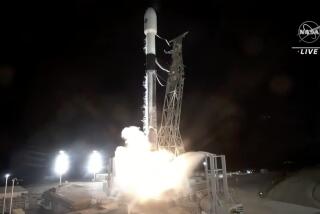The Challenger Probe Needs to Look Behind the Imagery
- Share via
Is this the way to investigate the worst space catastrophe?
The members appointed so far to the presidential commission investigating the Challenger explosion can’t be faulted for professional accomplishment or dedication to public service. But their mandate is limited to investigating the Challenger crash rather than looking into the precarious fundamentals of the shuttle program, a highwire act that finally ran out of luck.
That’s bad enough. But in addition, the commissioners are by and large the wrong bunch for penetrating the intricacies of NASA’s self-protective culture and producing the golden product that the space program desperately needs: a report that will eliminate any plausible doubts concerning what happened, who’s to blame, and whether the shuttle should fly again.
The commissioners, headed by former Secretary of State William P. Rogers, are either so remote from the shuttle program that they know little about it, or they’re so closely involved with it that their enthusiasm is overflowing.
Their varied backgrounds and interests suggest that they’d make a fine jury. But they’re not supposed to be hearing the results of an investigation, as would a jury. Rather, they’re supposed to be conducting an objective investigation of disaster in a highly technical enterprise.
The commission’s membership includes Air Force Maj. Gen. Donald J. Kutyna, who formerly headed the Pentagon’s shuttle program, and Neil Armstrong, immortalized as the first man on the moon, but long gone from the space program.
There’s also Sally Ride, the first American woman in space, and Chuck Yeager, the legendary test pilot who became a folk hero outside the space program. Another member is Richard P. Feynman, a Nobel laureate theoretical physicist, famously brilliant but never involved with space engineering. And there are several executives from major aerospace firms that do a lot of business with the National Aeronautics and Space Administration. The commission is notably long on publicly recognizable aerospace heroes and short on independent expertise in space engineering.
The boundaries of the inquiry have been circumscribed by President Reagan’s repeated assertions that the shuttle program is to proceed. With the presidential verdict already in, the theme is being echoed by NASA’s chief acting administrator, William Graham, who insists that the shuttle is an “operational system” that went awry just once in 25 flights.
“We don’t look like we’re going to have to go back to the design process again and envision reconfiguring the system or making a very major fundamental design change,” Graham said after the White House announced that the investigation NASA had started would be supplanted by the presidentially appointed commission.
NASA is both the object of the investigation and a participant in the conduct of it. The supply of evidence for the commission comes from NASA and presumably will be complete. But the flow has been rendered suspect by a rigorously enforced NASA news blackout which has, of course, energized the rumor mill.
Careers, reputations, and huge contracts are at stake in the investigation of the shuttle crash--and the telltale aroma of public-relations management is arising from the operation.
We’re also getting, and with justification, knowledgeable public expressions of skepticism about the quality of the investigation. Typical of them is a letter to the New York Times from a veteran rocket designer, Martin Summerfield, emeritus professor of engineering at Princeton University and president of Princeton Combustion Research Laboratories. None of the appointees to the commission, he noted, “have had any involvement in the engineering of solid-propellant rocket boosters, the prime suspect at this time.”
Nothing precludes additional appointments that would equip the commission with the kind of independent expertise that would help assure a thorough investigation. There’s ample talent in this big country to provide numerous candidates for the task--if the White House wants them.
The suspicion arises, however, that maybe it doesn’t. This Administration’s deft management of public sentiment and opinion is unprecedented. President Reagan’s performance at the rites for the shuttle’s seven crew members was somber and inspirational. The appointment of a presidential commission--traditional for dealing with great catastrophes--quickly followed, with the President saying he wanted a “calm and deliberate assessment of the facts.”
These are opening days of what may be a three-month inquiry, and perhaps the outcome will be a solid performance that merits public confidence. But on the basis of what has happened so far, there is ample reason to believe that the White House is more concerned with imagery than with engineering.
More to Read
Sign up for Essential California
The most important California stories and recommendations in your inbox every morning.
You may occasionally receive promotional content from the Los Angeles Times.










